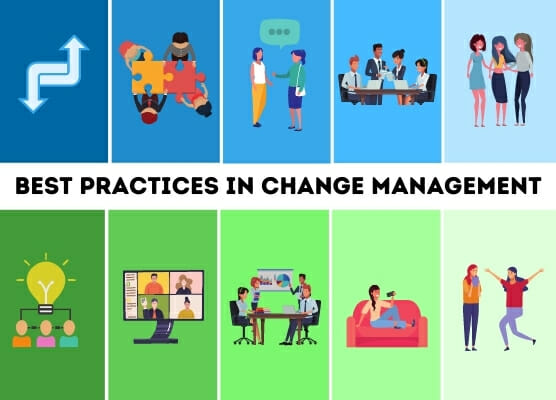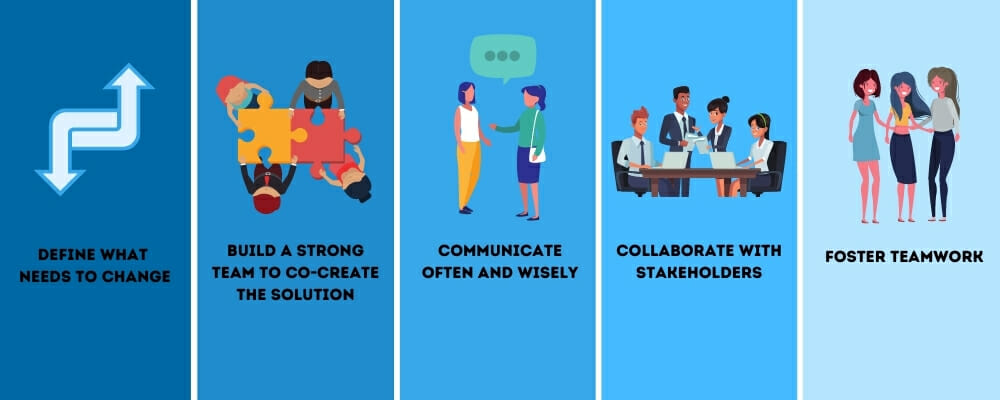10 best practices in change management

This year has been full of surprises – and change. Companies large and small are facing unprecedented times due to the COVID-19 pandemic.
As the country continues to reopen and many return to work under new guidelines, change management is the key to successfully facing these circumstances. As businesses reopen, a combination of change management and business continuity is needed to ensure the ongoing success of companies from every industry. Having a strategy in place that incorporates change management – and a roadmap to get back to meeting business goals is imperative.
What is change management?
Change management is a procedure that allows businesses to adapt to change to improve and enable long-term company success.
The value of change management is that it allows companies to get all employees on board with a vision. For it to be successful, individual employees must accept and implement the change.
Adopting change is difficult in the best of times, but navigating change while facing a global pandemic is something no business has met before. By using proven change management processes, your strategy can be successful even while navigating the new normal.
Change management process
The first step in change management is preparation – defining the goals and creating a strategy to help employees adapt and accept the changes. The next step is managing the change by steering employees through its implementation. Lastly, reinforce the change that has occurred by reinforcing behaviors, measuring impact, and monitoring adoption.
Because the effects of COVID-19 are so far-reaching, rethinking operating models and implementing changes will be necessary to respond to the economic and societal changes. Success in the new normal will require diligence, creativity, and adaptation while implementing change management processes.
Best practices in change management
When implementing change management, you want to consider best practices so your efforts lead to the level of desired impact.

Define what needs to change
Is there a process or tool that is impacting productivity or hampering sales? The first step is to identify what needs to change and build a sense of urgency around the need for improvement. When it comes to the pandemic, this might mean identifying safe ways to return to the office or establishing long-term plans for working at home.
Build a strong team to co-create the solution
Relying only on executives to create the change management strategy can lead to a failure in implementation. Ensure representation of all levels of the organization on the project team. Diverse perspectives and support will enable success. Often, these people are called change agents – and when it is time to implement the strategy, they are the key to driving change throughout the organization.
Communicate often and wisely
During times of change, it is especially important to focus on two-way communication, authenticity, and transparency. By creating conversations at all levels of the business, you can empower employees to be part of the change process, rather than at the mercy of it. They will feel involved and more likely to accept efforts to change if they can have input. Especially during the pandemic, communication from leadership should be frequent and authentic.
Communicating through virtual town halls, webinars, and other digital collaboration tools can be incredibly helpful in navigating change during this time. Ensure the available resources for medical and behavioral health are explained to employees and educate them on new practices and technologies that are in use as well.
Collaborate with stakeholders
Identifying and partnering with stakeholders is key to driving change. It is essential that both internal and external stakeholders are involved in the change management process and that communications to all stakeholders are aligned – the strategy message should be the same across the board.
To support stakeholders during the pandemic, it is vital to understand the effect of COVID-19 on customers, employees, investors, and suppliers. Mitigate the impact of the pandemic by implementing solutions that meet stakeholder needs.
Foster teamwork
Rally employees around the company purpose and encourage collaboration and new ideas. The status quo won’t work in today’s world, and teams will have to be reminded of the company’s vision and mission. Help them remember what the goals are and how the company will get there.

Overcome resistance
We are all resistant to change. Inevitably, employees who face both personal and work challenges during the pandemic may be resistant to change. Much has happened in a short time, and listening to employees and stakeholders is critical so that the emotion and overwhelm that many feel can be mitigated. Listen first, empathize, and then work to share the vision and strategy for the next steps.
Build organizational resilience
We’ve all had to respond rapidly to the COVID-19 crisis by implementing emergency plans, working quickly to enable remote work, meeting customer concerns, and reacting swiftly to change. Now is the time to stay true to the company’s culture and values so that the future of work is one of thriving and not just surviving. As employees see leadership act with resilience and courage, it cascades through the company.
Monitor and measure
Define both short- and long-term key performance indicators, and gauge frequently to ensure success.
This includes identifying what success would look like if all employees adapted the changes, asking how employees perceive the changes and soliciting feedback. You can do this through surveys or pulse checks that allow you to measure adoption, acceptance, and perception of the change. Evaluate progress and listen to feedback as part of the ongoing change management process.
Be willing to pivot
Be agile and willing to pivot if your measuring and monitoring reveal that employees and other stakeholders have not fully adopted the necessary change measures.
Since there are many unknowns and uncertainties around COVID-19, it is essential to remain agile. New information is becoming available at a rapid pace, and adapting change programs to incorporate further details is a priority. While many have focused on all that has been lost during the crisis, it will also bring new opportunities.
Being ready for the possibility that new business models may be required can position your company to capitalize on new options that become available.
Celebrate success
The goal is to move from survival mode as the pandemic emerged to a thriving mode as changes are implemented and a return to work and business continuity is established. It is important to recognize employees for their role in helping sustain companies during this unprecedented time. Many are making sacrifices and changes personally and professionally to ensure that their work is not impacted negatively by the new normal we are facing.
Change management takes a group effort
The economic and personal impact of COVID-19 is not over, but our ability to respond to it and navigate the changes that have come with it have improved.
We are collectively adapting to this global situation and learning to respond in a way that supports stakeholders and business strategy.
While we are still adjusting to the challenges that come our way through the pandemic, we can implement change management best practices to ensure that employees and stakeholders remain productive, engaged, and supported during this time.
By doing this, we can improve businesses’ economic outcomes, both large and small.







